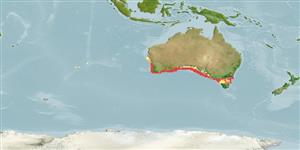Common names from other countries
Environment: milieu / climate zone / depth range / distribution range
Ecology
Marine; demersal; depth range 70 - 490 m (Ref. 6390). Subtropical; 27°S - 41°S
Indo-Pacific: endemic to the southern waters of Australia, from Marrawah in northwestern Tasmania to latitude 27°S off Western Australia. This species has been confused with Platycephalus speculator until recently.
Length at first maturity / Size / Weight / Age
Maturity: Lm 40.0, range 45 - ? cm
Max length : 70.0 cm TL male/unsexed; (Ref. 6390); 94.0 cm TL (female); max. published weight: 0.00 g; max. reported age: 20 years (Ref. 6390)
Occurs on the continental shelf and upper slope (Ref. 9563). Feeds primarily on fish, crustaceans and squid (Ref. 6390). Probably forms aggregations by sex (Ref. 27192). Sold as fresh, chilled, or frozen fillets in the domestic market.
Life cycle and mating behavior
Maturity | Reproduction | Spawning | Eggs | Fecundity | Larvae
Paxton, J.R., D.F. Hoese, G.R. Allen and J.E. Hanley, 1989. Pisces. Petromyzontidae to Carangidae. Zoological Catalogue of Australia, Vol. 7. Australian Government Publishing Service, Canberra, 665 p. (Ref. 7300)
IUCN Red List Status (Ref. 130435)
CITES (Ref. 128078)
Not Evaluated
Threat to humans
Harmless
Human uses
Fisheries: commercial
More information
ReferencesAquacultureAquaculture profileStrainsGeneticsElectrophoresesHeritabilityDiseasesProcessingMass conversion
Tools
Special reports
Download XML
Internet sources
Estimates based on models
Preferred temperature (Ref.
115969): 12.7 - 15.8, mean 14.4 (based on 15 cells).
Phylogenetic diversity index (Ref.
82804): PD
50 = 0.5000 [Uniqueness, from 0.5 = low to 2.0 = high].
Bayesian length-weight: a=0.00525 (0.00246 - 0.01120), b=3.04 (2.85 - 3.23), in cm Total Length, based on LWR estimates for this (Sub)family-body shape (Ref.
93245).
Trophic level (Ref.
69278): 4.0 ±0.59 se; based on food items.
Resilience (Ref.
120179): Low, minimum population doubling time 4.5 - 14 years (tm=4-6; tmax=20).
Fishing Vulnerability (Ref.
59153): Moderate to high vulnerability (53 of 100).
